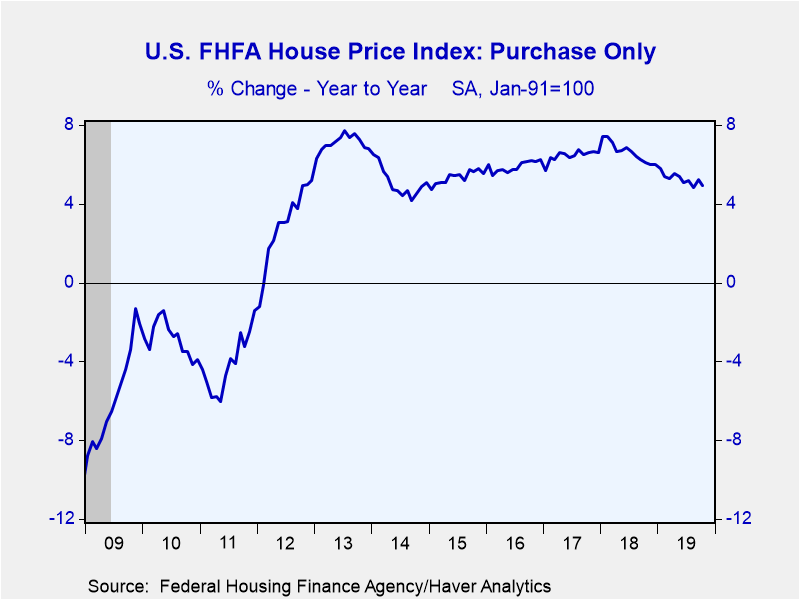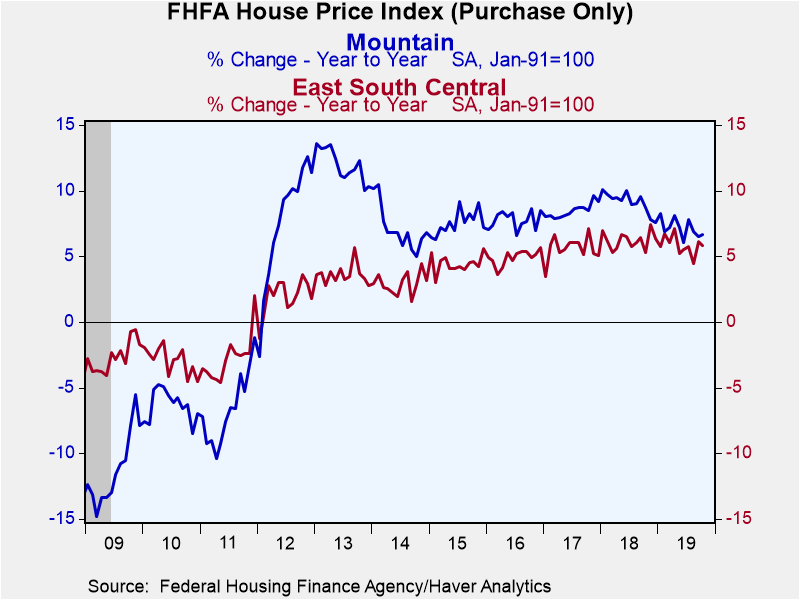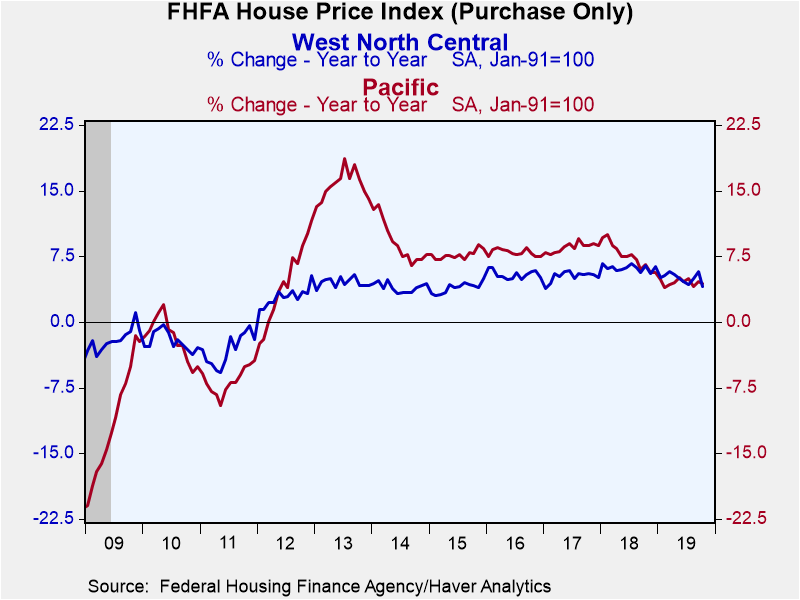 Global| Dec 31 2019
Global| Dec 31 2019U.S. FHFA House Price Index Edges Up in October
by:Sandy Batten
|in:Economy in Brief
Summary
The Federal Housing Finance Agency (FHFA) Price Index edged up 0.2% m/m (5.0% y/y) in October following an upwardly revised 0.7% m/m gain in September (initially 0.6%). The 5.0% y/y increase in October marked a sharp slowdown from the [...]
The Federal Housing Finance Agency (FHFA) Price Index edged up 0.2% m/m (5.0% y/y) in October following an upwardly revised 0.7% m/m gain in September (initially 0.6%). The 5.0% y/y increase in October marked a sharp slowdown from the 6.7% increase for all of 2018. In general, the y/y pace of house price increase has slowed over the past 18 months from a recent peak of 7.4% in February 2018. Over the last six months, prices increased at a 4.4% annual rate.
For the nine census divisions, seasonally adjusted monthly house price changes from September 2019 to October 2019 ranged from -0.5% m/m (+4.0% y/y) in the East North Central division to +0.7% m/m in the West South Central and East South Central divisions (+5.8% y/y and +4.6% y/y, respectively). The changes from a year ago were positive for each census division, ranging from +3.5% y/y in the New England division to +6.7% y/y in the Mountain division.
The FHFA house price index is a weighted purchase-only index that measures average price changes in repeat sales of the same property. An associated quarterly index includes refinancings on the same kinds of properties. The indexes are based on transactions involving conforming, conventional mortgages purchased or securitized by Fannie Mae or Freddie Mac. Only mortgage transactions on single-family properties are included. The FHFA data are available in Haver's USECON database.
| FHFA U.S. House Price Index, Purchase Only (SA %) |
Oct | Sep | Aug | Oct Y/Y | 2018 | 2017 | 2016 |
|---|---|---|---|---|---|---|---|
| Total | 0.2 | 0.7 | 0.2 | 5.0 | 6.7 | 6.5 | 6.0 |
| New England | 0.0 | 0.1 | 1.0 | 3.5 | 5.4 | 5.8 | 4.1 |
| Middle Atlantic | 0.6 | 0.4 | 0.4 | 5.0 | 5.5 | 4.8 | 3.6 |
| East North Central | -0.5 | 0.6 | 0.4 | 4.0 | 6.5 | 6.0 | 5.2 |
| West North Central | -0.2 | 0.8 | 0.8 | 4.1 | 6.2 | 5.3 | 5.5 |
| South Atlantic | 0.1 | 1.5 | 0.0 | 6.1 | 7.3 | 6.7 | 6.8 |
| East South Central | 0.7 | 1.6 | -0.4 | 5.8 | 6.2 | 5.7 | 5.0 |
| West South Central | 0.7 | -0.1 | 0.3 | 4.6 | 5.4 | 6.3 | 5.6 |
| Mountain | 0.4 | 0.8 | 0.1 | 6.7 | 9.2 | 8.6 | 7.8 |
| Pacific | 0.6 | 0.1 | 0.1 | 4.4 | 7.5 | 8.6 | 8.0 |
New England: Maine, New Hampshire, Vermont,
Massachusetts, Rhode Island and Connecticut.
Middle Atlantic: New York, New Jersey and Pennsylvania.
5East North Central: Michigan, Wisconsin, Illinois, Indiana and Ohio.
West North Central: North Dakota, South Dakota, Minnesota, Nebraska,
Iowa, Kansas and Missouri.
South Atlantic: Delaware, Maryland, D.C., Virginia, West Virginia,
North Carolina, South Carolina, Georgia and Florida.
East South Central: Kentucky, Tennessee, Mississippi and Alabama.
West South Central: Oklahoma, Arkansas, Texas and Louisiana.
Mountain: Montana, Idaho, Wyoming, Nevada, Utah, Colorado, Arizona and
New Mexico.
Pacific: Alaska, California, Hawaii, Oregon, Washington.
Sandy Batten
AuthorMore in Author Profile »Sandy Batten has more than 30 years of experience analyzing industrial economies and financial markets and a wide range of experience across the financial services sector, government, and academia. Before joining Haver Analytics, Sandy was a Vice President and Senior Economist at Citibank; Senior Credit Market Analyst at CDC Investment Management, Managing Director at Bear Stearns, and Executive Director at JPMorgan. In 2008, Sandy was named the most accurate US forecaster by the National Association for Business Economics. He is a member of the New York Forecasters Club, NABE, and the American Economic Association. Prior to his time in the financial services sector, Sandy was a Research Officer at the Federal Reserve Bank of St. Louis, Senior Staff Economist on the President’s Council of Economic Advisors, Deputy Assistant Secretary for Economic Policy at the US Treasury, and Economist at the International Monetary Fund. Sandy has taught economics at St. Louis University, Denison University, and Muskingun College. He has published numerous peer-reviewed articles in a wide range of academic publications. He has a B.A. in economics from the University of Richmond and a M.A. and Ph.D. in economics from The Ohio State University.










